Archaeologists Discover England’s Oldest Surviving Shipwreck
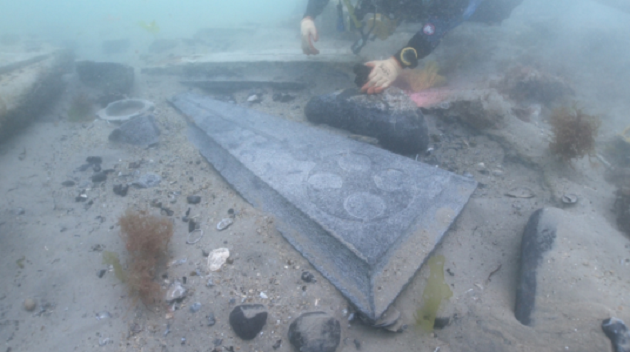
The 750-year-old medieval ship sank off the coast of Dorset during the 13th century, leaving behind remarkably preserved artifacts.
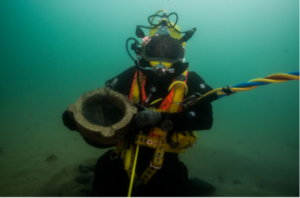
A diver retrieves artifacts from a recently discovered Medieval shipwreck. (all images courtesy Bournemouth University)
As pirates like to say, dead men tell no tales, but dead ships can hold a wealth of maritime history, when we’re lucky enough to find them. Researchers from Bournemouth University got extremely lucky, with the discovery of the remains of a 13th-century medieval shipwreck and its cargo, off the coast of Dorset. The ship is some 750 years old, and its survival is a complete anomaly, with no other known wrecks in English waters from the 11th to the 14th centuries, making this an extraordinary find. Analysis of the tree rings used in the hull construction indicated that they were Irish oaks felled between 1242 and 1265.
The find was the result of a decade-long partnership between researchers at the university, including Maritime Archaeologist, Tom Cousins, and local charter boat skipper Trevor Small.
“For the last 10 years we have been working closely with Trevor Small, hunting down and surveying wrecks in our local area from the 15th to the 20th century,” Cousins told Hyperallergic. “In 2019, at the end of a two weeklong scientific diving program, Trevor suggested we look at one more target on the seabed. We immediately saw the site’s significance with exposed mortars and timbers.”

Divers excavating gravestone slabs bearing 13th-century motifs from the seabed
“We were stunned to reveal immaculate grave slabs as well as a large section of the hull allowing us to date the ship to the 13th century!” said Cousins.
The ship features “clinker” construction, a method that employs overlapping planks to form watertight seals. The cargo, doomed to many centuries under the sea, turned out to be particularly suited to withstand such a trial; it was a lot of Purbeck stone, including several large stone mortars for milling flour, leading the find to be dubbed the “Mortar Wreck.” Purbeck is a limestone variant formed by the shells of freshwater snails under intense pressure and is able to be polished to a marble-like finish. This made it a popular material of the time, for Gothic construction across Britain and beyond, as well as for items like gravestones, two of which have been disinterred from the wreck intact. One of these slabs bears an early 13th-century wheel-headed cross motif, while the other features a splayed arm cross, typical of the mid-13th century, which has impacted the common understanding of historic gravestone production.
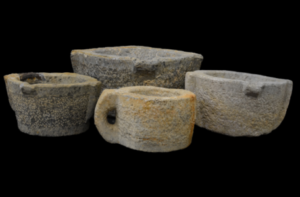
Purbeck stone implements found in the wreck
The team returned the following year to begin a larger investigation.
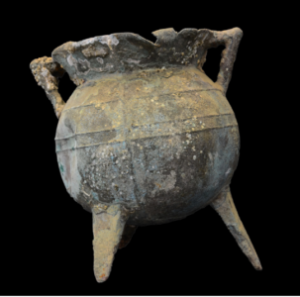
Other items found in the wreck included a cauldron used to cook food in, which would have been placed directly onto a fire.
“Even this early stage in the investigation, it has been clearly demonstrated that two cross head designs which were previously thought to be part of a developmental sequence were actually in use at the same time,” said Brian and Moira Gittos from the Church Monuments society in a statement from Bournemouth University. “Further work on the wreck is very likely to greatly enhance our understanding of the work of the medieval Purbeck marblers.”
Certainly, this is a monumental find, both literally and figuratively.

One of the Purbeck mortars, or millstones, to be used for grinding flour
“I was born into a seafaring family,” said Small, in the university statement. “I’ve skippered thousands of sea miles looking for shipwrecks from my home port of Poole. In summer 2020, I discovered what I believed to be an undetected wreck site … I was granted permission to dive the wreck. The rest is history! I’ve found one of the oldest shipwrecks in England.”
After years of excavation and research, cargo finds from the Mortar Wreck will go on display at Poole Museum in 2024 in three new maritime galleries that are part of a £4.3 million (~$5.235 million) redevelopment of the museum, supported by The National Lottery Heritage fund.
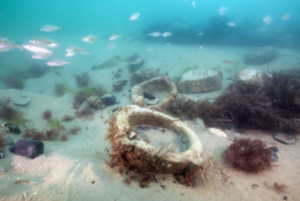
The Mortar Wreck, in situ




